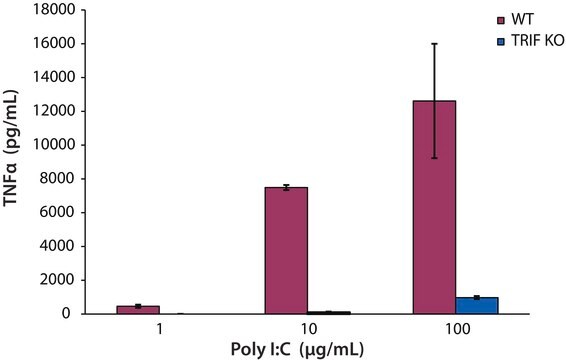L7261
Lipopolysaccharides from Salmonella enterica serotype typhimurium
purified by trichloroacetic acid extraction
Synonym(s):
LPS
Sign Into View Organizational & Contract Pricing
All Photos(3)
About This Item
Recommended Products
biological source
Salmonella enterica (Serotype typhimurium)
Quality Level
form
lyophilized powder
purified by
trichloroacetic acid extraction
impurities
1-10% Protein (Lowry)
color
white to faint yellow
solubility
water: 0.90-1.10 mg/mL, faintly hazy to hazy, colorless to faintly yellow
shipped in
ambient
storage temp.
2-8°C
Looking for similar products? Visit Product Comparison Guide
General description
This product is TCA extracted from Salmonella typhimurium. The source strain is ATCC 7823. This LPS serotype has been used to induce NOS in rats and guinea pigs.
Application
Lipopolysaccharides (LPSs) are characteristic components of the cell wall of Gram-negative bacteria. LPS and its lipid A moiety stimulate cells of the innate immune system by the Toll-like receptor 4 (TLR4), a member of the Toll-like receptor protein family, which recognizes common pathogen-associated molecular-patterns (PAMPs).
Biochem/physiol Actions
Lipopolysaccharides (LPS) are localized in the outer layer of the membrane and are, in noncapsulated strains, exposed on the cell surface. They contribute to the integrity of the outer membrane, and protect the cell against the action of bile salts and lipophilic antibiotics.
Preparation Note
The product is soluble in water (5 mg/ml) or cell culture medium (1 mg/ml) yielding a hazy, faint yellow solution. A more concentrated, though still hazy, solution (20 mg/ml) has been achieved in aqueous saline after vortexing and warming to 70-80 oC. Lipopolysaccharides are molecules that form micelles in every solvent. Hazy solutions are observed in water and phosphate buffered saline. Organic solvents do not give clearer solutions. Methanol yields a turbid suspension with floaters, while water yields a homogeneously hazy solution.
Other Notes
To gain a comprehensive understanding of our extensive range of Lipopolysaccharides for your research, we encourage you to visit our Carbohydrates Category page.
related product
Product No.
Description
Pricing
Storage Class Code
11 - Combustible Solids
WGK
WGK 3
Flash Point(F)
Not applicable
Flash Point(C)
Not applicable
Personal Protective Equipment
dust mask type N95 (US), Eyeshields, Gloves
Choose from one of the most recent versions:
Already Own This Product?
Find documentation for the products that you have recently purchased in the Document Library.
Customers Also Viewed
Jee Eun Choi et al.
Journal of immunology (Baltimore, Md. : 1950), 204(1), 13-22 (2019-11-24)
Activation-induced cytidine deaminase (AID) generates U:G mismatches in Ig genes that can be converted into untemplated mutations during somatic hypermutation or DNA double-strand breaks during class switch recombination (CSR). Null mutations in UNG and MSH2 demonstrate the complementary roles of
Marilena Antunes-Ricardo et al.
BioMed research international, 2015, 847320-847320 (2015-03-31)
Opuntia ficus-indica (OFI) has been widely used in Mexico as a food and for the treatment of different health disorders such as inflammation and skin aging. Its biological properties have been attributed to different phytochemicals such as the isorhamnetin glycosides
Melissa S Monson et al.
Scientific reports, 9(1), 13649-13649 (2019-09-22)
Exposure to high temperatures is known to impair immune functions and disease resistance of poultry. Characterizing changes in the transcriptome can help identify mechanisms by which immune tissues, such as the thymus, respond to heat stress. In this study, 22-day-old
Erika Muller Ramalho Zenha et al.
Journal of inflammation research, 5, 125-135 (2013-01-08)
The use of bacillus Calmette-Guérin (BCG) has long been considered a stimulus for immune reactivity in leprosy household contacts. Probably, the combination of multidrug therapy with BCG could facilitate the clearance of leprosy bacilli in the host, reduce relapse rates
Haibo Huang et al.
BMC genomics, 17, 322-322 (2016-05-05)
Thymus is the crucial site for T cell development and once believed to be immune privileged. Recently, thymus has gained special attention as it is commonly targeted by infectious agents which may cause pathogenic tolerance and subsequent immunosuppression. We analyzed
Our team of scientists has experience in all areas of research including Life Science, Material Science, Chemical Synthesis, Chromatography, Analytical and many others.
Contact Technical Service
